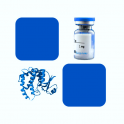
- Remove this product from my favorite's list.
- Add this product to my list of favorites.
Products
Newsletter
 |  |  |  |  |  |

Background
B-lymphocyte antigen CD19 is also known as CD19 (Cluster of Differentiation 19), is a single-pass type I membrane protein which contains two Ig-like C2-type (immunoglobulin-like) domains. CD19 is expressed on follicular dendritic cells and B cells. In fact, it is present on B cells from earliest recognizable B-lineage cells during development to B-cell blasts but is lost on maturation to plasma cells. It primarily acts as a B cell co-receptor in conjunction with CD21 and CD81. Upon activation, the cytoplasmic tail of CD19 becomes phosphorylated, which leads to binding by Src-family kinases and recruitment of PI-3 kinase. As on T cells, several surface molecules form the antigen receptor and form a complex on B lymphocytes. The (almost) B cell-specific CD19 phosphoglycoprotein is one of these molecules. The others are CD21 and CD81. These surface immunoglobulin (sIg)-associated molecules facilitate signal transduction. On living B cells, anti-immunoglobulin antibody mimicking exogenous antigen causes CD19 to bind to sIg and internalize with it. The reverse process has not been demonstrated, suggesting that formation of this receptor complex is antigen-induced. This molecular association has been confirmed by chemical studies. Mutations in CD19 are associated with severe immunodeficiency syndromes characterized by diminished antibody production. CD19 has been shown to interact with: CD81, CD82, Complement receptor 2, and VAV2.
Source
Recombinant human CD19 (20-291), Llama IgG2b Fc Tag, low endotoxin (CD9-H5250) is expressed from human 293 cells (HEK293). It contains AA Pro 20 - Lys 291 (Accession # P15391-1).
Predicted N-terminus: Pro 20
Molecular Characterization
This protein carries a llama IgG2b Fc tag at the C-terminus.
The protein has a calculated MW of 57.9 kDa. The protein migrates as 70-100 kDa under reducing (R) condition (SDS-PAGE) due to glycosylation.
Endotoxin
Less than 0.01 EU per μg by the LAL method.
Purity
>95% as determined by SDS-PAGE.
Formulation
Lyophilized from 0.22 μm filtered solution in PBS, pH7.4. Normally trehalose is added as protectant before lyophilization.
Reconstitution
Please see Certificate of Analysis for specific instructions.
For best performance, we strongly recommend you to follow the reconstitution protocol provided in the CoA.
Storage
For long term storage, the product should be stored at lyophilized state at -20°C or lower.
Please avoid repeated freeze-thaw cycles.
This product is stable after storage at:
-20°C to -70°C for 12 months in lyophilized state;
-70°C for 3 months under sterile conditions after reconstitution.
Bioactivity
Please refer to product data sheet.
(1) "Determinants of resistance to engineered T cell therapies targeting CD19 in large B cell lymphomas"
Sworder, Kurtz, Alig et al
Cancer Cell (2022)
(2) "STATUS OF THE CELLULAR IMMUNITY IN CLEAN-UP WORKERS OF THE CHORNOBYL ACCIDENT AND PATIENTS WITH CANCER OF THE MOUTH CAVITY, ORAL AND LARYNGEAL PART OF THE PHARYNX"
Zvarych, Bazyka, Ilienko et al
Probl Radiac Med Radiobiol (2022) 27, 324-340
(3) "NK-cell trogocytosis of CD19 antigen: a rare B-ALL MRD mimicker"
Panda, Pathak, Tejwani et al
Blood Res (2022) 57 (4), 249
Showing 1-3 of 14821 papers.
Welcome Login
Contact us
Follow us